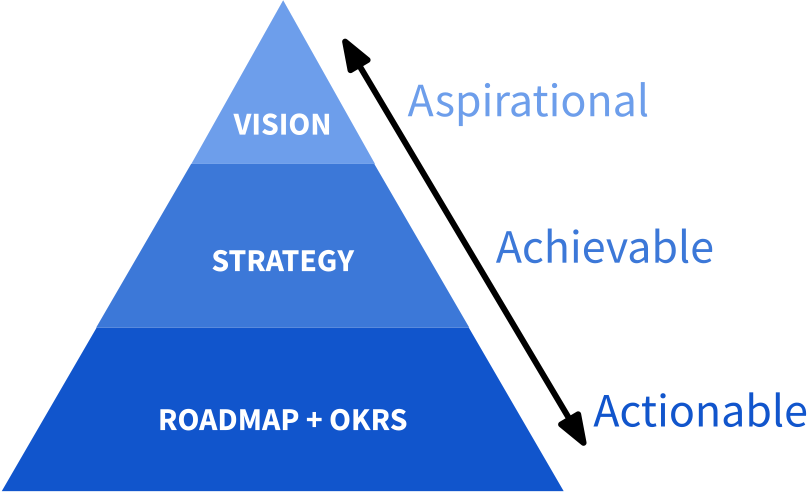2.1 Product strategy
Product strategy is about lifting our perspective and thinking big picture: Developing our overarching theme and delivering a product that fulfills customer needs.
Introduction
Too many product teams launch into the build phase before adequately determining the common themes that will drive success for their product. Technical execution is the easy part, and rarely the challenge. The hard part is figuring out how your product will make an impact. What features do your customers want so badly that they’ll choose your product over the competition? What’s so compelling they’ll go to the trouble of signing up and giving you their credit card number? And once you know that, how do you keep a laser focus on those compelling features — delivering exactly what your customer expects? How do you decide what is most impactful, and deliver those features first?
All of this gets to the heart of product strategy. Before we start figuring out specific, detailed product features — we need to lift our vision and think big picture. We need to know what the overarching theme is that will drive success across the product, and our business. Then we need to build that theme into our delivery strategy so we stay on-target.
This section on product strategy is, more than anything else, about creating alignment around your product’s strategic objectives. Misaligned product teams seldom meet user needs. The result? Products that fail to delight customers, and fail to make in impact — ultimately, wasting the time and money that went into developing them.
According to the Institute of Product Leadership, a product strategy is:
A high-level plan that outlines how a product will achieve its objectives and fulfill the needs of its target customers. It encompasses the decisions, actions, and approaches taken to position the product in the market, differentiate it from competitors, and create long-term value for both the business and its customers.
The playbook focuses on aligning delivery with an existing product strategy. If you want a deep dive on building a complete product strategy, which is a whole discipline, a good place to start is the Institute of Product Leadership.
Making our vision actionable
In the upstream playbook activity, 1.3 Product vision, we defined our vision statement and established an overarching long term direction and guideposts to protect product value.
The vision statement is aspirational and, accordingly, very high level. Now we start to make that vision achievable by developing a product strategy. In this activity, we determine the best strategy to successfully deliver objectives that fit our vision. Only after we have that can we move on to the actions that constitute delivery.
For our purposes, the product strategy will define the unique value proposition of our product, its target audience, and what key objectives we’ll build to achieve those goals.
Accordingly, in this activity we’ll develop:
Customer personas that model who are the customers that will use the product.
A value proposition, so we know how the product meets their needs.
Our business objectives, in order to deliver that value proposition.
This is the first step in turning the product vision into action. It may seem a bit far removed from writing code, but there are important reasons to make sure everyone understands the product strategy. You may need to do this a few times for it to become intuitive and natural.
Here are a few examples of the questions we’ll answer:
Are your customers young and tech savvy, or older and tech-averse? Understanding your customer is absolutely necessary when creating your user experience, otherwise you’ll miss the mark and the product won’t sell.
What problems do your customers have that we can solve? This informs what should be built first, making sure you launch high value features to attract users.
What differentiates your product from others? Features that protect your product value or are unique are the priority.
What protects your product from being duplicated? Having a strategy that builds a “defensive moat” helps preserve your position in the market. Again, these should also be a priority.
There’s a good chance your product development and market research team has already answered all of these questions. If so, that’s great! All you need to do in this activity is document them and make sure they align with delivery objectives. We’ll make it concrete by defining specific project initiatives.
If you use the referral button below, you’ll earn free premium access to Customer Obsessed Engineering. Just three referrals will earn a free month!



